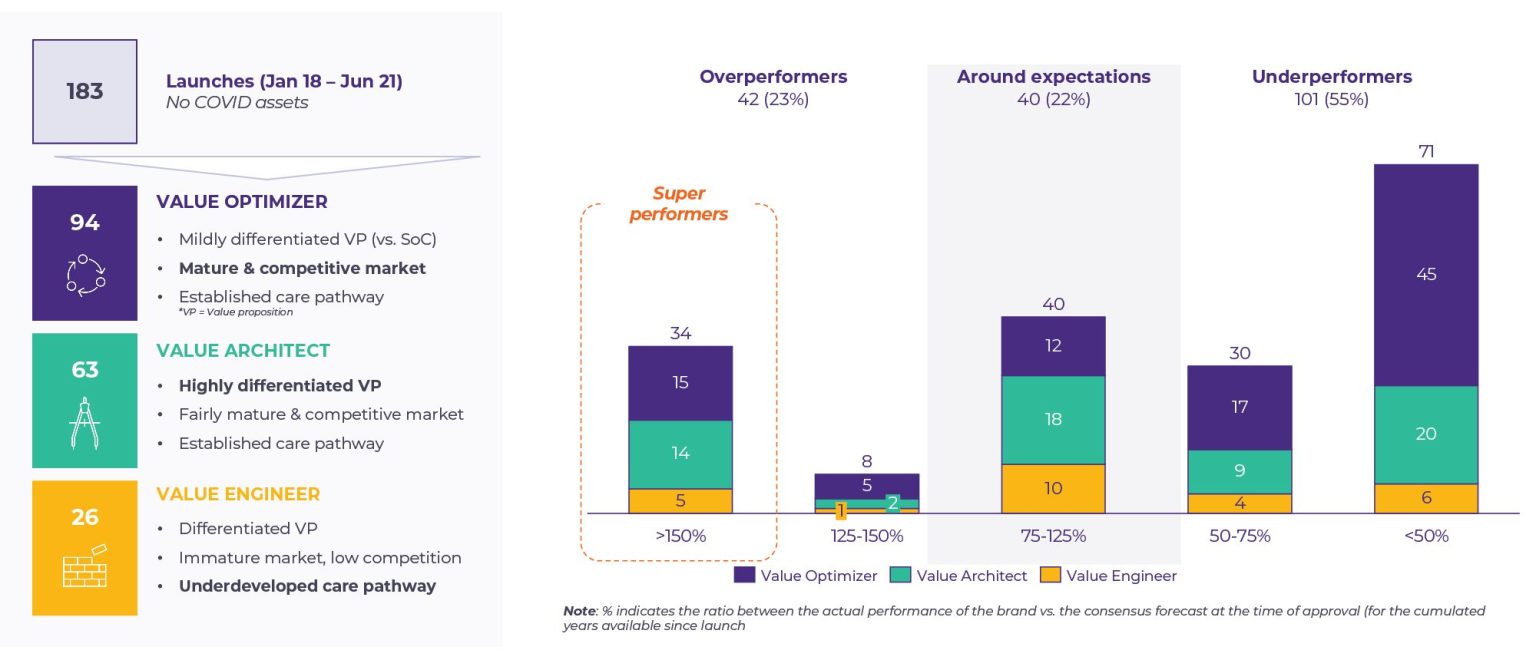5 value-creation system drivers for go-to-market success: Lessons from ~200 pharma product launches
In an increasingly complex and rapidly evolving healthcare environment, pharma leaders need to up their go-to-market (GTM) game to capture the value of pharmaceutical innovation. With the industry expected to add $450bn in revenue by 2028 (nearly 70% from new therapies), the stakes to get launches right have never been higher.
We have singled out the five key GTM drivers for establishing value-creating systems to support product launch excellence by reviewing the performance of nearly 200 launches since 2018 (within the context of major shifts affecting the pharma industry through this decade).
5 Major pharma shifts
Pharma companies must embrace five major shifts as they design a path to market for novel assets in an increasingly complex healthcare ecosystem.
Major shifts:
- Far fewer uncontested spaces and are more difficult to reach.
- New customer personas, more demanding and operating under unprecedented time pressure and resource constraints.
- Ever-rising funding pressure – further accentuated by COVID and the influx of medical innovations.
- Health systems evolution, both in terms of funding and (more integrated and interconnected) care delivery models.
- A shift towards more empowered frontlines to maximize customer proximity.
Lessons from ~200 product launches

Figure 1. Post-launch performance vs. pre-launch expectations (2018-21 launches, N = 183, Putnam analysis of Evaluate consensus forecast data).
More than 50% of recent launches (Figure 1) did not meet initial expectations. And 2 out of 3 launches in established therapy areas (Value Optimizer and Value Architect) underperformed.
In contrast, among the super-performers, Horizon Therapeutics’ Tepezza stands out as a true Value Engineer best practice. And this outstanding launch performance was a key contributor to the elevated horizon valuation of approximately $28bn when acquired by Amgen. Here are some of the key ingredients of its launch success:
- The creation of a large network of infusion centers.
- Activation of prescribing referral networks towards specialized centers.
- Rapid execution of DTC campaigns right after launch.
- Extensive peer-to-peer education to accelerate awareness around thyroid eye disease.
The research showed that laying the foundations of outstanding performance for novel assets starts with a clear-eyed view of what will matter in tomorrow’s market.
5 GTM drivers for establishing value-creating systems
Success and a reduction in hindrance across the ~200 launches can be distilled into five distinct drivers to create a value-creating system and impactful GTM strategy.
1. Develop high ecosystem IQ
By the decade’s end, pharma GTM models must create value for more complex care ecosystems as greater connectivity and interoperability emerge.
Successful launches will develop high ecosystem IQ to understand the environment and inter-connected stakeholders before launch to accelerate uptake.
Call to action:
- Boost market understanding of network dynamics via advanced analytics and early activation of in-field task forces to map out local ecosystems.
- Mindset shift to cross-functional, multi-stakeholder projects to address bottlenecks and build value-adding partnerships.
- Establish market development competencies (mature and fragmented therapies).
2. Articulate sharp value narratives
Intense competition and a narrower window of opportunity demand sharper value narratives.
Organizations will excel in elevating their narrative by engaging early on with the medical community and its thought leaders, payers, and patient advocacy groups – refining the value proposition and adequately characterizing target patient populations. They will increase the centrality of the medical frontline to help connect the dots between science, patients, and the required supporting evidence to drive optimal product utilization.
Call to action:
- Build strong advocacy and disseminate supporting evidence to create awareness and anticipation ahead of the launch.
- Evolve medical teams to be prime storytellers across multiple stakeholder audiences.
- Produce and deliver a compelling value story anchored in locally relevant data and co-created with key stakeholders early on along the drug development journey.
3. Establish a virtuous customer engagement continuum
The industry has accelerated its shift towards digital channels and more nuanced customer demands – the holy grail for high-performance organizations.
As highlighted by our benchmarks, organizations will seek to create a virtuous customer engagement continuum where each interaction point will add value and nudge the customer further along the adoption ladder.
Call to action:
- Enrich the traditional push and pull model by adding a third dimension, “re-frame,” to overcome HCP prescribing inertia via the delivery of relevant, customer-centric content and a more prominent role played by medical frontline teams.
- Anchor customer engagement strategies to up-to-date, more nuanced segmentations that systematically embed behavior and influence network dynamics.
- Deliver a recognizable and distinct customer experience with a virtuous customer engagement strategy that addresses both the individual and local ecosystem perspective.
4. Go all-in on patient experience
Overstretched healthcare systems, new care delivery models, and the availability of highly efficacious therapies with burdensome administration procedures are accelerating the need for patient services (e.g., Patient Support Programs, PSPs).
Organizations will unlock significant value by improving support and overall experience along the whole patient journey.
Call to action:
- Make PSPs a key component to drive the commercial success of the brand.
- Adequately fund investment into novel ways to uncover unmet needs and design best-in-class patient services.
- Integrate patient engagement strategies and execution into global brand planning activities and scale globally.
5. Empower frontlines to maximize “last mile” performance
The “last mile” of any GTM model is a key step to drive differentiation in crowded and complex markets, with frontline empowerment critical to achieving success.
Organizations will re-purpose frontline resources and transfer decision-making power closer to the frontline. This will be a must-have for organizations to increase customer proximity and maximize “last mile” performance.
Call to action:
- Build a microenterprise mentality providing frontline teams with greater decision-making power and resources to act as change agents to drive high-impact customer engagement.
- Shift from field operations to strategic project management to maximize customer engagement and enhance the patient journey at a local level.
- Rethink roles, competencies, and frontline organizational models in sync with the roll-out of technology enablers and consistent with a clear view of the “customer jobs to be done.”
Stand out in a complex healthcare ecosystem
Capitalizing on the value of novel assets is more important than ever with increasing payer scrutiny and the looming loss of exclusivity of the larger blockbusters. To recap, pharma leaders can achieve GTM excellence by establishing a value-creating system built on five key drivers.
- Develop high ecosystem IQ.
- Articulate sharp value narratives.
- Establish a virtuous customer engagement continuum.
- Go all-in on patient experience.
- Empower frontlines to maximize “last mile” performance.
Download the full whitepaper, Winning the Go-to-Market Game: Standing Out in Tomorrow’s Complex Healthcare Ecosystems, to dive deeper.

Jump to a slide with the slide dots.
 Lori Klein, PharmD
Lori Klein, PharmD
How Medical Affairs is Embracing AI to Drive Precision and Impact
Explore how AI is reshaping Medical Affairs, driving precision, enhancing patient outcomes, and unlocking new opportunities for biopharma in 2025
Read more Rudiger Papsch
Rudiger Papsch
MAPS EMEA 2025: Driving Transformation and Excellence in Medical Affairs
Explore how MAPS EMEA 2025 redefined Medical Affairs - patient-centricity, AI, evidence generation & launch excellence take center stage
Read more Jo Ann Saitta
Jo Ann Saitta
Why AI Needs Humans: The Critical Thinking Advantage in Pharmaceutical Commercialization
AI speeds pharma insights, but human experts turn them into action. ClarityNav blends AI power with strategic, real-world expertise.
Read more